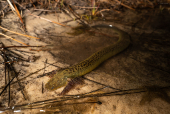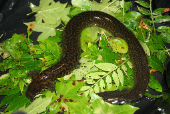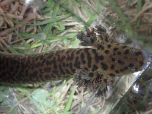Reticulated Siren (Siren reticulata)
Description: The reticulated siren is one of the largest species of extant (living) salamanders worldwide, reaching up to 2.0 feet in total length, which rivals the hellbender of the Appalachian Mountains as both the largest amphibian in North America and the fourth largest salamander in the world. It has a greenish grey, eel-like body, large external gills, and two small front legs. The sides and belly are a lighter yellowish green. It has an average snout to vent length (SVL) of 1.1 feet. S. reticulata differs from other Siren species in its skin patterning: a patchwork of dark, leopard-like spots covering its back. It also has a relatively smaller head and a longer tail.
Habitat: The habitat of S. reticulata includes wetlands within the longleaf pine ecosystem. S. reticulata, along with other Siren species, exhibits habitat specialization. S. reticulata inhabits shallow, seepage habitats (seeps) that are not commonly used by other species of the genus. These habitats are typically nutrient-poor and host a variety of carnivorous plants such as drosera, pitcher plants, bladderworts, and pinguicula. These unique ecological niches contribute to the diversity of Siren species and their adaptations.
Range: is found in shallow marshlands from Alabama through Florida's panhandle
Found in these States:
AL |
FL
Diet: Their principal diet is made up of aquatic insects and other invertebrates, which they catch at night.
Reproduction: Almost nothing is known about the life history or ecology of S. reticulata.
Status: Listed as Critically Imperiled in Alabama, and has No Status Defined in Florida.
Taxonomy: Genetic analysis from mitochondrial and nuclear sequencing supported it as a separate species from S. intermediaand S. lacertina, and further suggested that additional species are yet to be discovered in this group.
»» Kingdom: Animalia - Animals
»» Phylum: Chordata - Chordates
»» Subphylum: Vertebrata - Vertebrates
»» Class: Amphibia - (Amphibians)
»» Order: Caudata - Salamanders
»» Family: Sirenidae - Sirens
»» Genus: Siren
»» Species: Siren reticulata - Reticulated Siren
This article uses material from the Wikipedia article "Reticulated Siren", which is released under the Creative Commons Attribution-Share-Alike License 3.0. Content may have been omitted from the original, but no content has been changed or extended.
|












